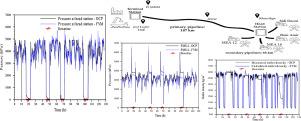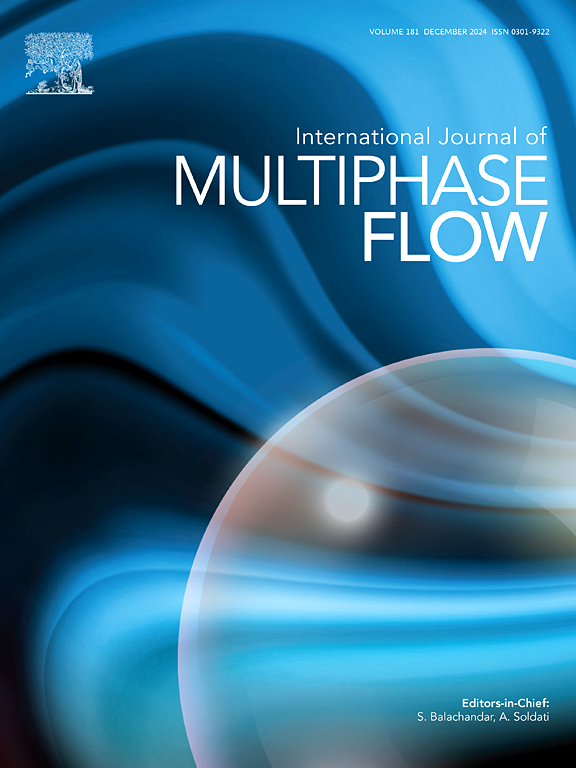Dynamic fluid flow model for phosphate slurry pipeline: OCP main pipeline as case study
IF 3.6
2区 工程技术
Q1 MECHANICS
International Journal of Multiphase Flow
Pub Date : 2024-10-03
DOI:10.1016/j.ijmultiphaseflow.2024.105011
引用次数: 0
Abstract
The transportation of phosphate slurry through large-scale pipelines presents significant challenges due to the complex behavior of multiphase flows, particularly with varying solid content, density, and dynamic viscosity. Efficient and accurate prediction of flow behavior is critical for optimizing the operation of such pipelines. This work aims to develop a dynamic computational model to simulate phosphate slurry flow in pipelines. The case study focuses on the OCP Group’s main slurry pipeline, which links the mining sites at Khouribga to the industrial plants at Jorf Lasfar, Morocco. This pipeline system spans a total length of 187.124 km, consisting of 5237 pipes with an inner diameter ranging from 0.8546 m to 0.8578 m, and features several elevation changes along its ground level. Using a section-averaged, dynamic approach and the Finite Volume scheme, the model computes essential flow parameters, including density, dynamic viscosity, and pressure, for the incompressible and non-Newtonian slurry and process water flows. The model’s accuracy is validated against on-site measured data, showing an average deviation of for outlet density, and below 10% for pressure along the pipeline, underscoring the model’s reliability. Additionally, a sensitivity analysis was conducted to illustrate the impact of key parameters on the predicted head losses and pressures along the pipeline. This analysis shows that the slurry viscosity is the most critical parameter, significantly influencing these predictions. This model provides high accuracy and reasonable CPU time for real-time simulation and monitoring, while also offering significant potential for optimizing pipeline operations and ensuring the reliability of phosphate transport.

磷酸盐泥浆管道的动态流体流动模型:以 OCP 主管道为例
由于多相流的行为复杂,特别是在固体含量、密度和动态粘度变化的情况下,通过大型管道运输磷酸盐浆料面临着巨大的挑战。高效、准确地预测流动行为对于优化此类管道的运行至关重要。这项工作旨在开发一种动态计算模型,以模拟磷酸盐浆液在管道中的流动。案例研究的重点是 OCP 集团的主要泥浆管道,该管道将位于 Khouribga 的采矿场与位于摩洛哥 Jorf Lasfar 的工业厂房连接起来。该管道系统总长 187.124 千米,由 5237 根管道组成,内径从 0.8546 米到 0.8578 米不等,沿地面有多处高程变化。该模型采用断面平均动态方法和有限体积方案,计算不可压缩和非牛顿泥浆及工艺水流的基本流动参数,包括密度、动态粘度和压力。根据现场测量数据对模型的准确性进行了验证,结果表明出口密度的平均偏差为 ±0.32%,管道沿线压力的平均偏差低于 10%,这充分证明了模型的可靠性。此外,还进行了敏感性分析,以说明关键参数对预测水头损失和管道沿线压力的影响。分析结果表明,泥浆粘度是最关键的参数,对预测结果有重大影响。该模型精度高,CPU 运算时间合理,可用于实时模拟和监控,同时还具有优化管道运行和确保磷酸盐运输可靠性的巨大潜力。
本文章由计算机程序翻译,如有差异,请以英文原文为准。
求助全文
约1分钟内获得全文
求助全文
来源期刊
CiteScore
7.30
自引率
10.50%
发文量
244
审稿时长
4 months
期刊介绍:
The International Journal of Multiphase Flow publishes analytical, numerical and experimental articles of lasting interest. The scope of the journal includes all aspects of mass, momentum and energy exchange phenomena among different phases such as occur in disperse flows, gas–liquid and liquid–liquid flows, flows in porous media, boiling, granular flows and others.
The journal publishes full papers, brief communications and conference announcements.

 求助内容:
求助内容: 应助结果提醒方式:
应助结果提醒方式:


